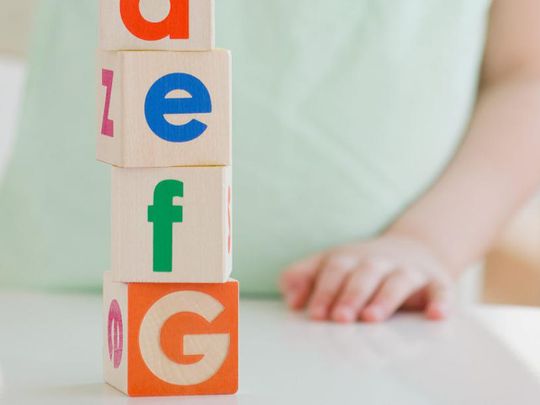
As kids hit toddlerhood, making sure they’re on track with major development milestones such as talking can sometimes be difficult to judge.
But when kids hit toddlerhood during a pandemic - when they’ve likely been kept out of group childcare environments, had way more screen time than you would otherwise have liked, and spent a lot of time being spoken to by masked adults – it can be much harder.
“Preventative practices such as mask wearing, social distancing, and virtual meetings and classrooms to address contagion concerns may negatively affect communication, particularly in the paediatric population,” says Sara A Charney, a speech language pathologist at Mayo Clinic and the author of research article ‘Potential Impact of the COVID-19 Pandemic on Communication and Language Skills in Children’.
“Although more studies are needed to characterize the pandemic’s impact on paediatric speech and language development, clinicians and parents should be cognizant of this phenomenon and proactive in facilitating an optimal communication environment for children.”
A rising problem
Even before COVID hit, experts had noticed a rise in problems among young children in the UAE, with prevalence of speech-sound disorders (SSD) such as stuttering, apraxia, lack of social communication and other impairments affecting around nine percent of kids. Roughly five to eight percent of preschoolers experience language delays that continue throughout their school years and into adulthood, while 15-20 percent of two-year-olds are delayed in their expressive language development.
“Red flags to watch out for at any time in those up to four years old include any loss of speech or babbling, never gesturing or imitating, not appearing to understand speech or to hear very well and never developing words beyond repeating what others say,” says Rugaiyah Majed Hamidaddin, a speech-language Pathologist who has previously worked at the Child Early Intervention Medical Center (CEIMC) in Dubai.
“Research confirms that the first five years in a child’s life from the building blocks for later life,” adds Vandana Gandhi, founder and CEO of British Orchard Nursery. “It is important that we are vigilant in our observation of physical and mental progress at this age. This can only be achieved through a combined effort of teachers as well as parents.”
The importance of early intervention
If you suspect a problem, the earlier a child receives the help he or she needs, the better the outcome.
“Early intervention also reduces behavioural problems such as anxiety of low self-esteem that may occur due to a speech or language issue,” says Rugaiyah. “As a starting point, get a hearing test done if their child is not responding normally since hearing disorder could be the root of the problem. If in doubt, consult a speech-language therapist. Getting an appointment is the first step in providing your child with the help he or she needs but you may encounter long waiting lists for speech therapy services, which can be frustrating when you’re anxious to help.”
When to talk to your child’s doctor
A baby who doesn't respond to sounds or regularly vocalize should be checked by a doctor right away, according to Dayton Children’s Hospital. But often, it's hard for parents to know if their child is taking a bit longer to reach a speech or language milestone, or if there's a problem that should be cheked.
Dayton Children’s shares some things to watch for...
Call your doctor if your child by:
- 12 months isn't using gestures, such as pointing or waving bye-bye
- 18 months prefers gestures over vocalizations to communicate, has trouble imitating sounds or understanding simple verbal requests
- Two years can only imitate speech or actions and doesn't produce words or phrases naturally, says only some sounds or words repeatedly and can't use oral language to communicate more than their immediate needs, can't follow simple directions or has an unusual tone of voice (such as raspy or nasal sounding)
Additionally, call your pediatrician if your child’s speech is harder to understand than expected for their age:
- Parents and regular caregivers should understand about 50% of a child's speech at two years
- Parents and regular caregivers should understand about 75% of a child's speech at three years
- By four-year-old, a child should be mostly understood, even by people who don't know the child
Tools you can use at home
If you don’t need or want to see a specialist yet but would like to do something to boost your child’s language skills in the meantime, there’s lots you can do to give your child’s speech and language therapy a head start, as Rugaiyah suggests…
• Talk while doing things and going places.
• Use simple but grammatical speech that is easy for your child to imitate.
• Expand on words. For example, if your child says "car," you respond by saying, "You're right! That is a big red car".
• Make time to read to your child every day. Try to find books with large pictures and one or two words or a simple phrase or sentence on each page. Name and describe the pictures on each page.
• Have your child point to pictures that you name.
• Sing songs, play finger games and tell nursery rhymes. These songs and games introduce your child to the rhythm and sounds of language.
• Strengthen your child's language comprehension skills by playing the yes-no game.
• Sort pictures and items into categories and ask your child to point out the item that does not belong in a category.
• Read books that have a simple plot, predict and talk about the storyline. Help your child to retell the story, or his or her favourite part, or act it out with props and dress-up clothes.
• Look at family picture, and have your child explain what is happening.
• Work on comprehension skills by asking your child questions. Have him or her try to fool you with his or her own questions. Pretend to be fooled!
• Talk about spatial relationships (first, middle and last; right and left) and opposites (up and down; big and little).
• Offer a description or clues and have your child identify what you are describing.
• Expand on social communication and storytelling skills by "acting out" typical scenarios with a dollhouse and its props.
• Follow your child's directions as she or he explains how to do something.
• Give full attention to your child when he or she is speaking and acknowledge, praise, and encourage him or her afterward.
• Build on your child's vocabulary. Provide definitions for new words, and use them in context.
• Encourage him or her to ask for an explanation if he or she does not understand.
• Ask "wh" questions (who, what, when, where, or why) when reading a book or watching television and monitor his or her response.
• Give your child two-step directions and encourage he give them to you.
• Have your child help you plan and discuss daily activities.








